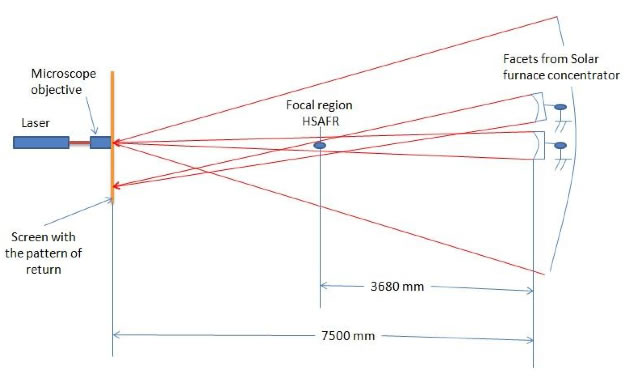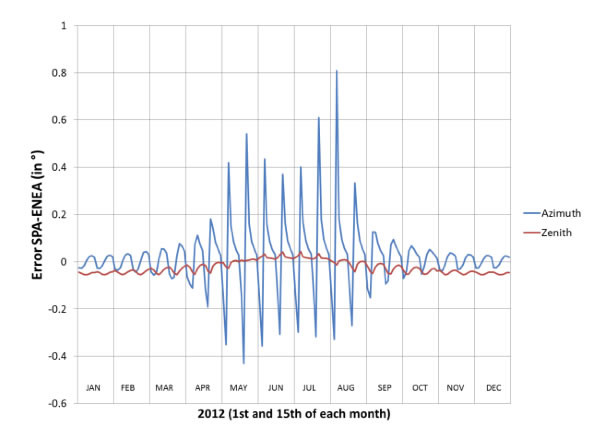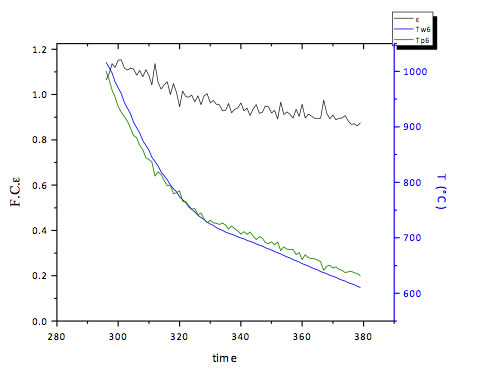Mostrando artículos por etiqueta: HoSIER Memorias
Method for Facets’ Alignment for the High-Flux Solar Furnace at CIE-UNAM in Temixco, Mexico. First Stag
Abstract
The new high radiative flux solar furnace is being developed in Mexico at the Centro de Investigación en Energía of the Universidad Nacional Autónoma de México. The alignment of the facets of the concentrator is a key procedure to obtain the required energy distribution in the focal zone and to keep the global standard deviation of the optical errors low. We present a novel method for optical alignment of the facets; this alignment procedure requires a simple optical system, allows rapid alignment and guarantees the required accuracy. Preliminary results obtained with this procedure are discussed, which show that the facets alignment satisfactorily meets specifications.
S. Vazquez-Montiel, C.A. Pérez-Rábago, R. Pérez-Enciso, D. Riveros-Rosas, F. Granados-Agustin, C.A. Arancibia-Bulnes, C.A. Estrada

Control System for the High-Flux Solar Furnace of CIE-UNAM in Temixco, Mexico. First Stage
Abstract
This paper presents the control system design of a new high flux solar furnace that is being developed in Mexico at the Center for Energy Research of the National University of Mexico. The control of the whole system is critical for the correct operation of it. The control system consists of a rugged PC running state machine-based software which manages the operation of all the user interfaces for the furnace systems which are the heliostat, shutter, cooling, visual and data acquisition subsystems, as well as the positioning desk control. The control routines run in real-time controllers dedicated for each subsystem. The computer routines used by the main program and the tests made for characterizing the heliostat follow-up system is also described. Preliminary results obtained shows that the heliostat control presents great versatility due to the type of control it has, including the possibility of accepting feedback through images projected by it.
C.A. Pérez-Rábago, R. Guzmán-Galán, N. Flores-Guzmán, E. Brito, D. Marroqui-García, R. Pérez-Enciso, D. Riveros-Rosas, C.A. Arancibia-Bulnes, C.A. Estrada
Control System for the High-Flux Solar Furnace of CIE-UNAM in Temixco, Mexico. First Stage

Correction of the Concentrated Sunlight Spot’ s Drift of the CIE-UNAM Solar Furnace
Abstract
This paper discusses the methods implemented for the solution of the drift and backslash problems in the heliostat of the High Radiative Flux Solar Furnace recently built at the Center for Energy Research of the Universidad Nacional Autónoma de México, located at the geographical coordinates 18° 50' 24" North and 99° 15' 00" West. To solve the observed drift, various algorithms were analyzed for the calculation of the solar vector,and a closed loop through an electronic device was implemented which makes corrections to the position of the heliostat. Drift was corrected by means of unbalancing the heliostat.
R. Pérez-Enciso, E. Brito-Bazan, C. A. Arancibia-Bulnes, D. Riveros-Rosas, C. A. Perez-Rábago, J.J.Quiñones, C. A. Estrada
Correction of the Concentrated Sunlight Spot’ s Drift of the CIE-UNAM Solar Furnace

Three-dimensional analysis of solar radiation distribution at the focal zone of the solar furnace of IER-UNAM
Abstract
Since August 2011, the 30 kWt Solar Furnace for Higher Radiative Fluxes (HoSIER) of the Renewable Energy Institute (former Center for Energy Research) of the National University of Mexico (IER-UNAM) is in operation. The optical design of the HoSIER-UNAM includes a total of 409 spherical facets, divided into 5 different focal length groups [1]. A ray-tracing simulation was carried out to realize a three-dimensional analysis of the concentrated solar radiation distribution at the focal area of the HoSIER. In this way, theoretical profiles of the radiative flux were obtained. To get the experimental profiles of the concentrated solar irradiance of the HoSIER, a Lambertian screen was placed in the focal zone, normal to the optical axis of the concentrator. The screen was movedalong 10 cm on the focus with each flat separated 5 mm of distance and in front of a CCD 8-bit digital camera. With the CCD was possible to obtain several experimental radiative flux distributions and thus it was possible to validate the ray-tracing simulation. This comparison shows a very good agreement between experimental and theoretical distribution.
R. Perez-Enciso, D. Riveros-Rosas, M. Sanchez, C.A. Pérez-Rabago, C.A. Arancibia-Bulnes, H. Romero-Paredes, C.A. Estrada

Estudios calorimétricos para la medición de propiedades opto-térmicas en sólidos sujetos a altas temperaturas y altos flujos radiativos
Moreno-Álvarez L., Pérez-Rábago C., Pérez-Enciso R., Estrada C.
Abstract
In this work we show the analytical study of radiative heat exchange in a proposed calorimeter to measure the properties of absorptivity and emissivity of materials under high temperatures produced by the highly concentrated solar radiation of the Solar Oven at Renewable Energy Institute of UNAM (HoSIER), that allowed us to detect the need for a modification to the design of the prototype in order to get proper measurements.
Dependencia de la emisividad con la temperatura de una superficie receptora sometida a radiación altamente concentrada
Carlos Pérez-Rábago, Lúar Moreno-Álvarez, Ricardo Pérez-Enciso, Alejandro Bautista-Orozco y Claudio Estrada
Abstract

Experimental results of the campaign to determine a method for measuring the temperature of a surface exposed to the highly concentrated radiation at HoSIERthrough three different conditions: quartz window, PYREX® window and without window are presented in this paper. It seeks to achieve a method for measuring the surface temperature without any thermocouple contact, preventing its overestimation due to the effect of the surface's radiosity itself.This methodology is able to determine a correction factor of the emissivity (FCε) depending on the incident temperature. In addition to determine the temperature difference overestimated due to the component of the radiation reflected by the surface.
Transient heat transfer simulation of a 1 kWth moving front solar thermochemical reactor forthermal dissociation of compressed ZnOH
Abstract
A 1 kWth cavity-type solar reactor devoted to the thermal reduction of volatile oxides as part of a two-step thermochemical cycle is analyzed numerically. The thermochemical reactor consists of a vertical-axis cavity-type receiver in which the reactant is injected from the bottom in the form of an ascending rod made of a stack of zinc oxide compressed pellets undergoing thermal dissociation. A transient heat transfer model allows the simulation of the thermal behavior under real conditions for the rod of reacting particles exposed to concentrated solar radiation. The developed numerical model couples radiation, conduction and convection heat transfers to the kinetic of the reaction. The incident solar irradiation on the reactant surface is obtained using the Monte-Carlo ray tracing technique applied first to the solar concentrator and second to the reactor cavity. The model is used to predict the temperature profile from the irradiated front surface of the compressed reactant, the evolution of outlet oxygen molar flow-rate during the reduction reaction and the instantaneous thermochemical efficiency, as a function of time. The calculated results are compared with the experimentally obtained data. The agreement between experimental data and simulation related to both the temperature and the oxygen progress is fairly good with Ea = 380 kJ mol−1 and k0 = 246 × 106 mol m−2 s−1 for the kinetics of the ZnO dissociation reaction.
H.I. Villafán-Vidales, S. Abanades, M. Montiel-González, H. Romero-Paredes, C.A. Arancibia-Bulnes, C.A. Estrada, Chemical Engineering Research and Design
